Order up
When buying and selling stock or options, there are many different order types to choose from. Every type has its own pros and cons and in this article, we’ll touch on some of the more common ones.
Market Order
With a market order you specify the amount of contracts or stock that you want and hit submit. A market order tells your broker to just take whatever price is there. This is like the crack addict order. You need it and you need it now at any cost. Like with crack, the cost can be steep and leave you living on the street.
The only time I’ve seen this be applicable in my trading life is when a price moved through my stop and I was stuck on the wrong side and getting wronger quickly. I just wanted to be out since I’ve already lost more than intended and a market order got the job done.
Limit Order
For our trading style here at Stock Johnson, limit orders are where it’s at. Especially when trading stock options since the prices and spread can be very volatile at times.
Limit orders are instructions to your broker to buy a specified amount of stock or contracts and a certain price or better. It lets you lock in your price you want or else the trade will not execute. It’s best to decide your entry price and stick to that limit. I spent many years chasing the price by moving my limit up and up trying to get my order filled only to have it fill at a terrible price then drop back down to where I originally wanted to enter the trade.
Limit orders are also a good way to exit your trade but the only issue is it can cap your gains. If you know you will be happy with the limit price you’ve set for an exit, then do you. That’s awesome! For myself and a lot of my colleagues, we prefer to use stop limits to try to capture more of any potential profit. More on stop limits in a moment.
Stop Order
I’m sure by now you’ve heard it preached over and over again. Always trade with a stop. That is great advice but which stop do you use? A stop loss specifies to exit your position (or the amount of shares/contracts specified by you) once the last traded price matches your specified stop price. The only issue with this is it tells your broker to fire off a market order whenever the stock or option trades at your stop price.
Say you buy a stock at $100 and you’re a responsible person who wears khakis and gets your oil changed on time. You set your stop at $98 and cross your fingers hoping it goes to $110 to give you a great risk to reward. Meanwhile, the whole board of directors siphons off all the cash from the company to their own pockets and the stock price is tanking. It trades at $98 to activate your stop. The problem here is there are no buyers at that price due to the news. So your market order gets filled at $90 because that’s the next best price. Enough of this slippage in your execution prices can really eat into your profits long term.
Stop Limit
Here we go. This is the kind of order we like. A stop limit order tells your broker to activate a limit order to exit your position once the stock or option price hits your specified stop. This is great to keep slippage to a minimum and still protect you from losing too much. The issue is when the price blows through your stop and your limit order doesn’t get executed. Now you still own your position at a bigger loss than intended and your limit order is sitting there waiting for the price to return.
The way we like to use stop limit orders is to manage our winners. Depending on the trade plan, we will sometimes move our stops up to break even as soon as the trade is green. If it continues trending in a profitable direction we will manually move the stop up. We’ve had a lot of success with this strategy but it does require you to actively be there managing your position in order to lock in your gains.
If you like a more hands off approach this next order type might be for you.
Trailing Stop Limit
There are trailing stop orders where it will trigger a market order when it hits your trailing stop but by now you should know how we feel about those.
Trailing stop limit orders are still just stop limit orders but as the name implies, your stop now trails behind the last traded price at a distance specified by you. You can set your trailing stop based of a dollar amount or percentage away from the last traded price. The trailing stop will only go up and will stop increasing its stop amount if the price begins to head in the opposite direction.
For example, you buy some stock for $100 in the middle of a strong uptrend. You want to make a quick buck but you have your Gamblers Anonymous meeting to attend so you can’t really watch your position. So you enter a trailing stop limit order that says to trail the price by $2. As soon as you enter that trailing stop order the stop price is set at $98.
The stock rallies all the way to $110 before it takes a breather. Your stop rallies with it but $2 behind so now your stop price is set at $108. The stock retraces back to $105 before making its next move. Not to worry though because your stop remained at $108 and triggered your limit order to activate once the stock price hit $108.
As far as the limit order goes, you can set it to match the stop price, you can set it to be 0.5% below the stop price, you can set it to be $3 above the stop price if that makes sense for your crazy trade idea. It’s very customizable and self-sufficient.

